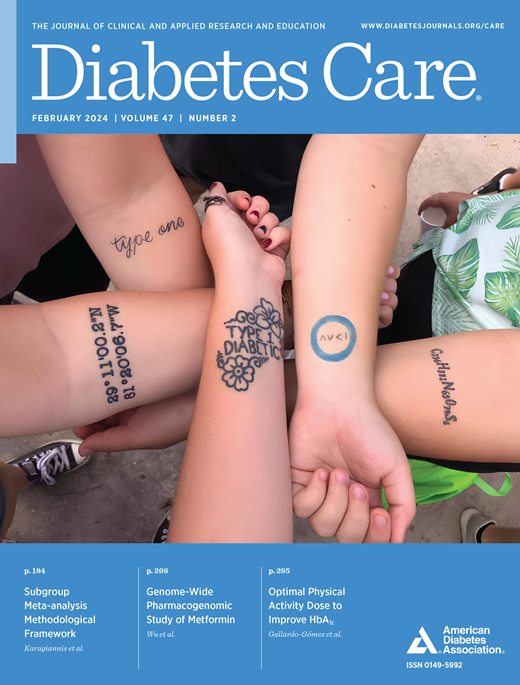Influence of Maternal Glycemia on Breast Milk Composition and Volume Ingested by Infants of Mothers With Type 1 Diabetes
IF 16.6
1区 医学
Q1 ENDOCRINOLOGY & METABOLISM
引用次数: 0
Abstract
OBJECTIVE To examine relationships between maternal glucose and breast milk composition and volume ingested by infants of mothers with type 1 diabetes (T1D), and to compare breast milk composition in women with and without T1D. RESEARCH DESIGN AND METHODS Midfeed breast milk samples were collected from 11 mothers with T1D. Maternal continuous glucose monitoring data were correlated with breast milk composition and volume ingested. Breast milk composition was compared between the women with T1D and five without T1D. RESULTS Forty-seven breast milk samples from mothers with T1D were analyzed. Maternal glucose 90–120 min before breastfeeding correlated with breast milk glucose and fructose but not with lactose, protein, fatty acids, leptin, or volume consumed. Breast milk leptin correlated with volume of breast milk consumed (r = 0.394; P = 0.008). Higher breast milk glucose (1.0 ± 0.3 vs. 0.7 ± 0.3 mg/mL) and leptin (463.6 ± 480.0 vs. 114.4 ± 68.6 pg/mL) were found in women with versus without T1D. CONCLUSIONS Maternal glucose is associated with breast milk glucose and fructose in women with T1D but not with volume of breast milk consumed.母亲血糖对1型糖尿病母亲的婴儿母乳成分和摄取量的影响
目的 研究 1 型糖尿病(T1D)母亲的母体血糖与母乳成分和婴儿摄入量之间的关系,并比较有 T1D 和无 T1D 母亲的母乳成分。研究设计与方法 收集了 11 位患有 T1D 母亲的母乳样本。母体连续血糖监测数据与母乳成分和摄入量相关联。比较了患有 T1D 的母亲和五位未患有 T1D 的母亲的母乳成分。结果 对患有 T1D 的 47 位母亲的母乳样本进行了分析。母乳喂养前 90-120 分钟母体血糖与母乳葡萄糖和果糖相关,但与乳糖、蛋白质、脂肪酸、瘦素或消耗量无关。母乳瘦素与母乳量相关(r = 0.394;P = 0.008)。发现患 T1D 的妇女与未患 T1D 的妇女相比,母乳葡萄糖(1.0 ± 0.3 vs. 0.7 ± 0.3 mg/mL)和瘦素(463.6 ± 480.0 vs. 114.4 ± 68.6 pg/mL)更高。结论 母体血糖与 T1D 女性的母乳葡萄糖和果糖有关,但与摄入的母乳量无关。
本文章由计算机程序翻译,如有差异,请以英文原文为准。
求助全文
约1分钟内获得全文
求助全文
来源期刊

Diabetes Care
医学-内分泌学与代谢
CiteScore
27.80
自引率
4.90%
发文量
449
审稿时长
1 months
期刊介绍:
The journal's overarching mission can be captured by the simple word "Care," reflecting its commitment to enhancing patient well-being. Diabetes Care aims to support better patient care by addressing the comprehensive needs of healthcare professionals dedicated to managing diabetes.
Diabetes Care serves as a valuable resource for healthcare practitioners, aiming to advance knowledge, foster research, and improve diabetes management. The journal publishes original research across various categories, including Clinical Care, Education, Nutrition, Psychosocial Research, Epidemiology, Health Services Research, Emerging Treatments and Technologies, Pathophysiology, Complications, and Cardiovascular and Metabolic Risk. Additionally, Diabetes Care features ADA statements, consensus reports, review articles, letters to the editor, and health/medical news, appealing to a diverse audience of physicians, researchers, psychologists, educators, and other healthcare professionals.
 求助内容:
求助内容: 应助结果提醒方式:
应助结果提醒方式:


